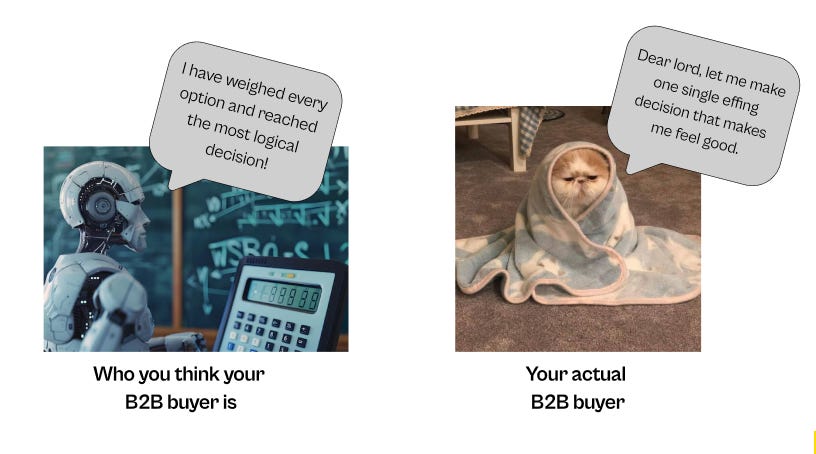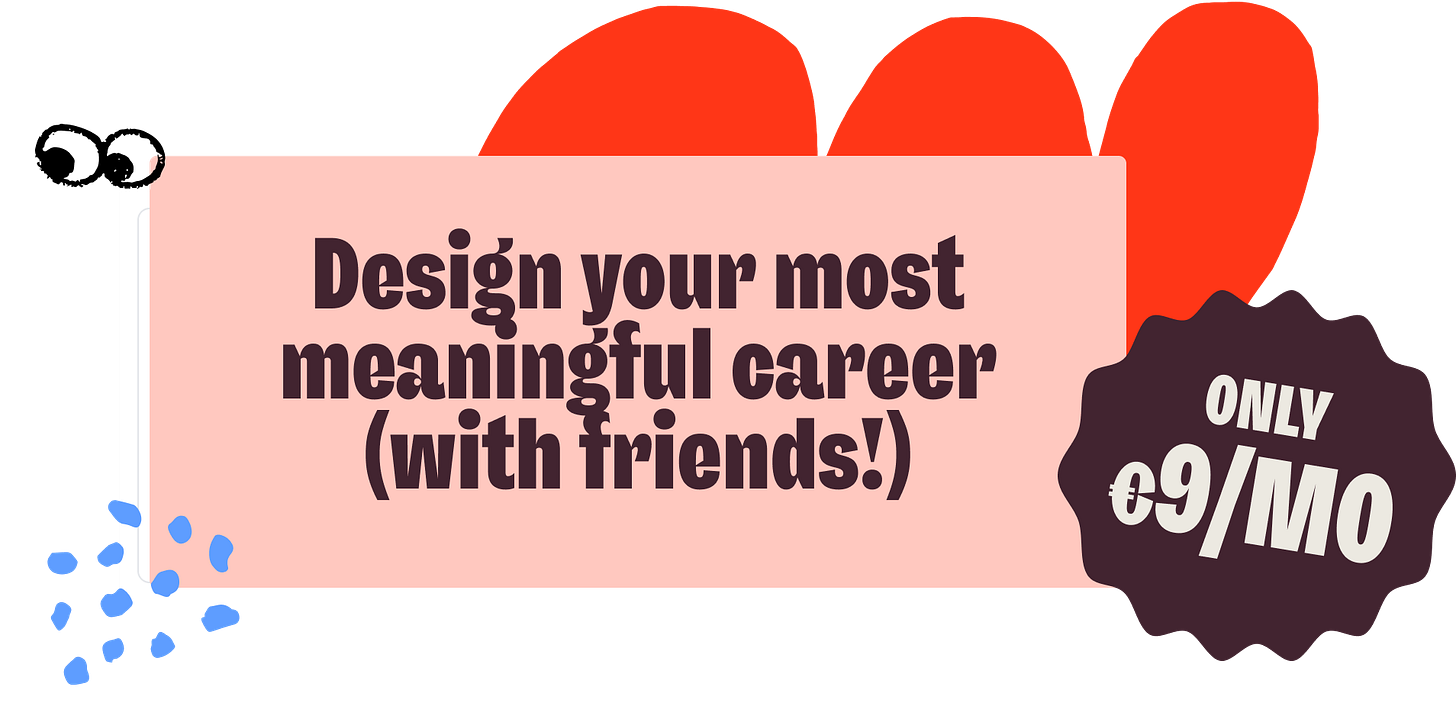5 things B2B gets wrong about brand
If we had a nickel for every client doing something on this list...
Hi there! You’re reading the Bonfire newsletter from Kevan Lee & Shannon Deep. Each week, we highlight brand, marketing, and creative learnings from our experience as in-house marketers turned agency owners who think a lot about creativity, our relationship to work, and how all of that impacts our identities. We’ll also feature insights from our digital community of super smart folks (which you’re welcome to join).
Wishing you a great week!
5 mistakes that boring B2B brands are always making
A couple weeks ago, Kevan and I had a lot of fun doing a webinar for Wynter called Unboring Your Branding, which you can watch in its entirety here (for free!).
In it, we got to talk about the foibles and pitfalls of B2B branding with a lot of enthusiasm and, ahem, candor. Because despite all the talk about differentiation and connection and trust...most B2B brands still blend together into a feature-soup of sameness.
So today, we’re calling out the five mistakes we see over and over again that are not-so-quietly killing your brand—and boring the hell out of your buyers.
1. Caring too much about ROI
The B2B obsession with performance metrics is detrimental to quality brand building, full stop. Yes, ROI matters. Yes, there are lots of ways to measure that ROI and to quantify a brand’s impact beyond ROI—even a B2B brand.
But too often, both with our Bonfire clients and with our former in-house roles, we saw this:
If it can’t be measured, it gets cut.
If it can be measured, it gets over-optimized to death because experimentation is verboten.
The result? Marketing that’s predictable, forgettable, and easy to ignore—and not actually that performant after all.
You want efficiency over time? Invest in brand. It builds trust, affinity, and reputation over time (we said over time!). It’s the multiplier that makes every channel work harder in the long run. Like, over time.
2. Conflating product positioning with brand positioning
If we had a nickel for every time someone shared a brand positioning that was actually a product positioning…
Your product positioning tells me what your thing does. Your brand positioning tells me why I should care.
Those are not the same thing.
But in B2B, the two get mashed together all the time—and suddenly you’ve got a homepage that reads like a spec sheet and a “mission” statement that’s really just a feature list in disguise.
And so do all your competitors.
Brand is emotional. It’s aspirational. It makes me feel like my choosing your brand says something about me. If you're only speaking to logic, you're missing half the brain.
When you use your product positioning as a stand-in for your brand positioning, it’s like Ken from the Barbie movie whose job is just “beach.”
Like…your brand is “fast and accurate”? Your brand is “the most comprehensive”? That’s your whole brand?
Wow. So cool. What a multidimensional company you must be. ::quietly navigates away from homepage::
3. Letting sales mess everything up
We said what we said.
Too many B2B orgs let sales override brand by taking what works on a sales call or in a demo environment and letting it flow back up the messaging cascade to become the brand message.
Call it voice of the customer. Call it being close to your audience.
That’s awesome. Truly. It is an incredibly important layer in the big marketing cake.
But it’s not your brand.
Let what’s working in sales dictate your brand, and messaging gets diluted. Strategy gets bypassed. Consistency is nonexistent.
You shouldn’t be asking your audience who you are—you should be telling them! Because you’ve thought about it and made decisions. Because you have an idea of who you are and want to be in the future. Otherwise, you’re just at the mercy of the newest thing the AEs say is working that week, reactive and opinionless, building no trust or reputation apart from the strength or weakness of your frontline sales org.
This is why sales enablement is such an important marketing function! Sales needs this kind of marketing support so that there is a responsive feedback loop of what’s working and what’s changed with all the materials to support it. But those materials need a filter. And that filter is the brand.
4. Being afraid to stand for something... Anything! Please!
A divisive brand is not a bug—it’s a feature. It lets the people who are with and for you know that they are with and for you. Because if you try to appeal to everyone, you’re mostly appealing to no one.
The most effective brands take a stand—about what they believe, how they work, what they’re against. And saying your brand should be “divisive” or “against” something doesn’t necessarily mean that your brand is negative or controversial. Those are separate issues! You can be divisive in that you draw a bright line between those who prioritize legacy ways of working and what’s new and experimental. You can be against negative things like waste or inefficiency or bias.
For a long time, Salesforce made a name for itself with a brand campaign using the strapline “No Software” and proudly declaring they were going to “end software”—the implication being, of course, that SaaS was the future. And who doesn’t remember Apple’s anthropomorphized Mac vs. PC commercials of the mid-aughts? These brands solidified their own POVs by clarifying what they weren’t as well as what they were!
It can be a tough pill to swallow that you might not win every heart or mind, but at least you’ll win some, and be assured that the ones you do win are true fans. Be brave! You’ll stand out.
5. Measuring long-term impact with short-term KPIs
If you’re trying to measure the success of your brand with clickthrough rate, you’re gonna have a bad time.
Brand isn’t built in a quarter. It’s built through consistent experience, repetition, resonance, and trust. As we’ve said a million times before, brand is the sum of all experiences someone has with your company over time.
That’s why brand metrics require a different lens:
Are we becoming more memorable? (Aided and unaided brand awareness surveys)
Are we more appreciated? (Brand sentiment surveys)
Is our brand point of view part of the conversation in our industry? (Share of voice percentage)
Do more people have the opportunity to interact with us? (Brand reach score)
Notice that none of those things has a DIRECT pipeline metric, but I’ll refer you back to point #1! If you only measure what's immediate, you’ll keep choosing mediocre stuff that gets clicks but lacks any kind of story or throughline.
And if you want help measuring what you can and qualifying what you can’t check out our two mini-courses on Gumroad:
Bonus bungle: Treating your buyers like robots, not people
I know we love to think about B2B buyers the same way that economists think of consumers: Totally rational calculator-literate people who always act in their best interest, with perfect information, uninfluenced by emotion.
Get outta here!
We promise you, your B2B buyers are just people. They like things that people like. They like to be entertained. They like to feel understood. They like when things look nice and are easy to accomplish. You know, just like you do.
And, we know this flies in the face of all the B2B “wisdom” you might hear, but B2B buyers also have emotions! (Gasp! Perish the thought!) And brand’s whole dealio is to leverage story and psychology in service of appealing to emotion.
Leader: “No, no! They don’t like creative brand stuff. Our buyer is super skeptical—”
Brand: “Yeah. So they feel skepticism. Like an emotion?”
Leader: “Uh…no. For them, it’s all about getting information so that they trust—”
Brand: “Incredible! Trust is also something you feel. Did you know that?”
Leader: “GIMME A SPEC SHEET AND LEAVE ME ALONE.”
Brand: ::brushes up their resume::
Anyway! If you want more details on all of the above, give our free Wynter webinar a watch. We unpack all this and more, plus you’ll get to see our faces as we rant about things for once!
Over to you…
Where do you see B2B branding falling short at your orgs? Or! How about we be optimistic and ask for B2B brands that are truly nailing it? Share your favorites, too!
Join us in Campout
In Campout, our digital community, we talk about stuff like this on the daily in our channels and a couple times a month in our live events. All supported by exercises and templates to help you craft a career with purpose and intention.
Check out our new mini-course called Career Compass. It’s a fresh approach to career design and the basis for a lot of the career advice we’ve been giving folks lately. You can breeze through the content in less than an hour … or about the time it takes to watch one episode of The Gilded Age!
Want to hang out with us next week? Join our digital co-working session this Wednesday, August 27, to see some friendly faces while you work. These sessions are chill and casual—we just want to provide an outlet for human connection in the otherwise Slack-filled workday. RSVP here to add it to your calendar!
And join now to browse our event library and catch replays of…
Career Clarity Workshop with us, Kevan & Shannon
Design a Life That Energizes You with Rachel Korb
Personal Brand on Your Terms and Conditions with Callie Rojewski
Beyond AI Prompts: How to Sound Human When the Robots Want You Basic with Meg Moore
Find Your Fit: Reshaping Your Work, Not Yourself with Mary Jantsch
But wait! There’s more…
Wanna hang out?
We’re SOLD OUT for our first retreat this fall, but you can join the waitlist for our next one, coming spring of 2026.
Wanna be friends?
If you love this newsletter and wish it were more interactive, you’re in luck! Join us over in Campout, our digital community for creative marketers and the creative curious.
Wanna work with us?
If you need help with brand strategy and storytelling, fractional brand and marketing leadership, and bringing your brand strategy to life in impactful ways, send us an email at hello@aroundthebonfire.com to get in touch.
As always, you can find us on LinkedIn, Instagram, and Threads.








100%! The human aspect always gets lost behind the B2B label, but behind every buyer is a heart! Speak to a person, not a robot.
It's kinda the opposite of the brand/product positioning conflation you mention, but I also see a lot of brand positioning that product realities wholly fail to live up to. While it's not unusual for there to be a delta between market promises and product realities, I think brand is always a bit of a mirror/window thing, where you both reflect the truth of what you are (mirror), while looking out and aspiring to be what the market wants (window). I see a lot of orgs go all-in on window and wind up choosing a brand identity that doesn't reflect the reality of who they are in their bones, what they've built, how they conduct themselves, etc.